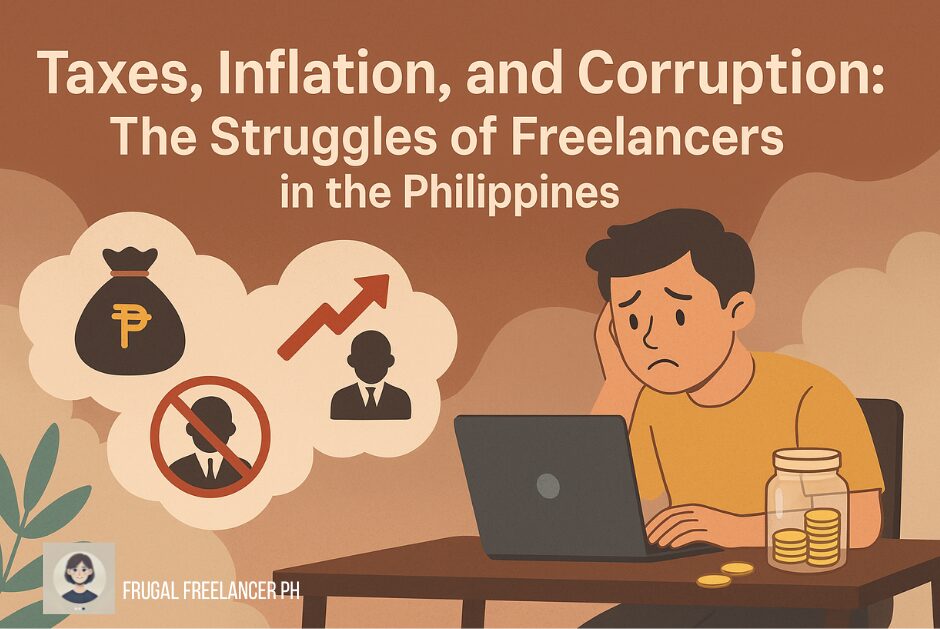Freelancing in the Philippines often gets painted as a dream: flexible hours, working from home in your tsinelas, and earning in dollars while sipping kape in your sala. But behind the Instagram-worthy laptop lifestyle is a much less glamorous reality—one shaped by three heavyweight opponents: taxes, inflation, and corruption.
Let’s be honest: freelancers in the Philippines aren’t just fighting client deadlines. We’re also battling a system that often feels rigged against us.
Contents
The Tax Burden Nobody Warned Us About
According to the Bureau of Internal Revenue (BIR), self-employed individuals—including freelancers—are required to pay income tax, percentage tax (if applicable), plus contributions to SSS, PhilHealth, and Pag-IBIG. Sounds fair… until you realize how much that slices out of a beginner freelancer’s budget.
A freelancer earning ₱15,000/month (about $260) is still expected to file taxes – even if that amount is barely above the minimum wage in Metro Manila.
Add SSS, PhilHealth, and Pag-IBIG contributions, and suddenly your take-home pay looks like it went on a crash diet.
The bigger problem? Many freelancers avoid registering altogether. Not because they’re lazy, but because the return on investment feels questionable. You pay, but do you really get reliable benefits?
Inflation Eats First, You Eat Later
Every time inflation spikes, freelancers feel it twice as hard.
📌 Example: In August 2025, Philippine inflation hovered around 4.4%, driven by food and fuel prices. For freelancers who earn in pesos (or convert USD to pesos), that means:
- Your groceries get more expensive.
- Your bills rise.
- Your rates… often stay the same.
A “decent” $300/month contract can vanish faster than your kuryente bill when onions cost ₱200/kilo again.
And unlike salaried workers, freelancers don’t have mandated COLA (Cost of Living Allowance). We either negotiate with clients or absorb the hit.
Corruption: The Silent Tax
Here’s the kicker: corruption makes all of this worse.
Funds that could improve internet speed, modernize government systems, or subsidize healthcare often “disappear.” And when public money vanishes, freelancers (along with the rest of the working class) foot the bill in hidden ways:
- Poor infrastructure = unreliable internet = lost clients.
- Bloated projects = higher taxes.
- Misused funds = inflation stays sticky, wages don’t catch up.
In short: freelancers (or should I say EVERYONE) pay real money for ghost services.
So, How Do We Survive?
We can’t fix corruption overnight (kahit sana pwede, no?). But we can outsmart the system in small, practical ways:
Protect your income. Always use secure payment platforms (PayPal, Wise, Payoneer) and written contracts.
Budget for volatility. Inflation is real. Build a cushion for months when rates stay flat but expenses rise.
File smart, not scared. If your income is low, check BIR thresholds – some freelancers may qualify for exemptions or minimal tax dues.
Invest in yourself. Better skills = higher rates = more room to breathe when the economy feels suffocating.
Build an Emergency Fund. This is your safety net. Kahit uncertain ang taxes, inflation, o clients, an EF buys you peace of mind. Kahit 1–3 months’ worth of expenses muna, life saver na ’yan kapag biglang na-late ang client payment or nagka-unexpected gastos.
Join communities. The more freelancers push for transparency and support, the harder we are to ignore.
Final Word
Freelancing in the Philippines is a masterclass in resilience. We juggle clients abroad while navigating a system at home that doesn’t always play fair. Taxes bite, inflation burns, and corruption? It lingers like a background noise we can’t mute.
But here’s the thing: we’re still here. We’re still showing up with our laptops, negotiating rates, and building careers in spite of it all.
Because if there’s one thing Filipino freelancers know best, it’s this:
👉 We don’t just survive. We innovate, we hustle, and we thrive – even when the odds aren’t stacked in our favor.
💡 Up Next on the Blog:
A lot of you might have been asking: “What if I only earn ₱15,000 a month as a freelancer? Do I still need to file taxes?”
Don’t worry, I’ve got you covered. In my next post, I’ll break down the rules, thresholds, and practical tips so you’ll know exactly where you stand.
👉 Stay ahead, not confused. Subscribe to the Frugal Freelancer PH Newsletter so you won’t miss it.
Disclaimer: Please note that some of the links on this blog may be affiliate links, meaning I may earn a small commission if you make a purchase or take an action through those links. This comes at no extra cost to you. I only recommend products or services that I personally trust and believe will add value to my readers. Thank you for supporting my blog!

No Responses